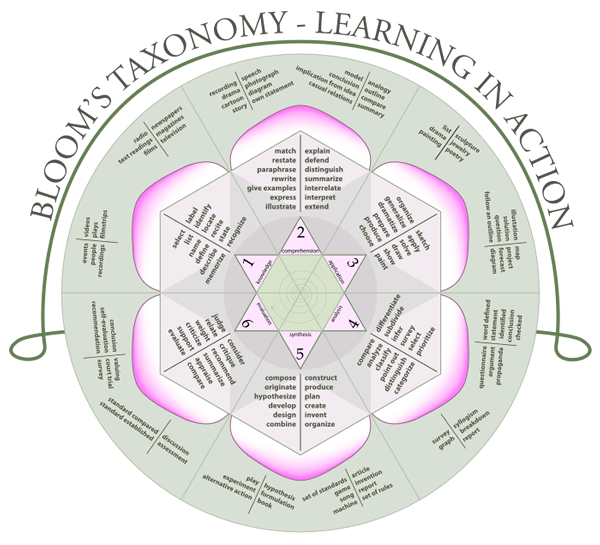Lesson 10: Using Tests, Assignments, and other Tools to Evaluate Learning Outcomes
Attention
If you click on this image you can download a full-resolution copy of this image in PDF format.
This lesson will explore the types of tools used in online instruction to measure learning outcomes. Special attention will be paid to utilizing the tool that most accurately measures the identified learning outcome based upon Bloom's Taxonomy of Learning Objectives.
Learning Outcomes
Upon completion of this lesson's material, Faculty will be able to:
- Explore a variety of levels and domains within Bloom's Taxonomy and their assessment within Blackboard.
- Create a new, or modify an existing, Lesson Plan utilizing additional learning outcomes and assessments.
Teaching
You have learned in the ALOTA model that there is a connection between identified Learning Outcomes and Assessments. Learning Outcomes define what you want your students to know or do...assessments are the tools that you use to have them DEMONSTRATE what they know and what they can do.
Learning Outcomes
One of the most popular models for defining different learning outcomes comes out of the work of Benjamin Bloom in 1956. The organization of different types of Learning Outcomes into different DOMAINS and within a HIERARCHY relative to one another has come to be known as "Blooms Taxonomy of Learning Objectives."
While studying at Boise State University, one of my professors put together a document that outlines each Domain (Cognitive, Affective, and Psychomotor) and each of the levels in each domain, along with a guide on developing Learning Outcomes and the adjectives used.
Click HERE to see Dr. Yonnie Chyung's document!
RIGHT CLICK HERE to download another interactive Quicktime tutorial I developed. This one has you identify the hierarchy of a learning outcome statement based on Blooms Cognitive Domain. (Be sure to RIGHT CLICK this file and download it for it to work!)
Alignment with Tools in Blackboard
SPECIFIC tools in Bb are appropriate for measuring SPECIFIC levels of learning outcome. So, once you have written out your Learning Outcomes the next step is to select the best tool to measure it.
Example: Let's say I set a Learning Outcome in THIS lesson as follows: "Students will provide an example of a learning outcome at each level of Bloom's Hierarchy in the Cognitive Domain" What tools in Bb could I use to have students do this?
As you can see there are many ways in which you can assess that particular learning outcome using the tools in Bb. The key is to structure your tool in a way that will enable your students to demonstrate what they know. Instructions on your expectations should be very clear. You can see below, in each of these lesson plans, that I explicitly describe what I want you to do to demonstrate your knowledge and skill, in the Assessments section of the lesson. |
So the task here is to FIRST define good, measurable learning outcomes and then select the best tool possible to measure your student's performance.
Assessment
Lesson 10 Discussion
Use this discussion to ask questions about this lesson and to discuss the content.
Lesson 10 Assignment
For this lesson I want you to construct an "Assessment Plan" for a Lesson in your class. In this document I want the title of the lesson, a list of the Learning Outcomes that you created and a PLAN for how you are going to measure each outcome.
Remember, if you write that you are going to expect an Learning Outcome, you HAVE to measure it...if you are not going to measure the outcome then don't include it in the list!
Lots of learning occurs "on the side" in a class...sometimes we leave some of the learning UN-assessed because we don't want to burden our students with too many assessments.
